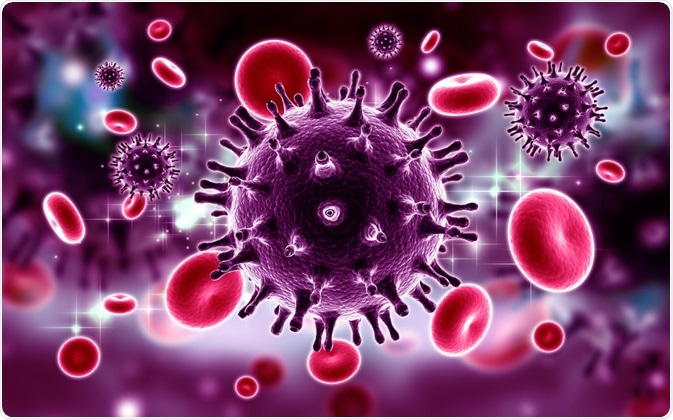Evidence for Stem Cell Transplantation as a Cure for HIV-1

A long-term follow-up study of a second London patient has demonstrated a successful stem cell transplantation from donors harboring an HIV-resistant gene. Blood taken from the patient revealed an absence of no active viral infection 30 months following cessation of antiviral therapy.

Image Credit: RAJ CREATIONZS/Shutterstock.com
The case report published in The Lancet HIV Journal effectively demonstrated the second person documented to have been cured to HIV. Crucially, although no active viral species remained in the patient’s blood, there was evidence of integrated HIV-1 DNA in the tissue sample.
The primary success of this study is the demonstration of the complete absence of HIV-1 replication in samples of multiple bodily fluids including cerebrospinal, blood, intestinal, semen, and lymphoid tissue. The remnants of integrated HIV-1 are regarded as ‘fossils.
Although promising, the treatment is high-risk. This places this treatment as a viable offer for patients only suffering from hematological malignancies as a last resort.
This study also represents the use of CCR5 gene editing as a curative therapy outside of gene editing. Although promising the scalability of CCR5 gene editing is limited – following technical and ethical barriers associated with its use.
The Berlin patient: the first curative treatment for HIV-1
This patient follows the Berlin patient reported in 2011, who was cured of HIV-1 using stem cell transplantation. This patient was subject to two rounds of full-body radiation and allogeneic hemopoietic stem-cell transplantation (allo-HSCT).
The cells transplanted harbored a CCR5Δ32/Δ32 mutation, inhibiting cellular expression of CCR5, a that results in HIV-1 resistance. These stem cells replace immune cells with populations harboring this mutation, which causes the inhibition of viral replication. Concurrent total-body irradiation and chemotherapy ablate cells already harboring HIV-1 infected cells.
A two-step treatment: reduced intensity drug regimens and allogeneic stem-cell transplantation
Gupta et al. conducted viral load sampling from the London patient's intestinal lymphoid and cerebrospinal fluids at 29 months following cessation of antiretroviral therapy (ART) and viral load sampling of their blood at 30 months. CD4 cell count, taken as an indication of the robustness of the immune system and indication of successful stem cell transplantation, was taken.
Results showed that the measured patient CD4 count was reflective of a slow reconstitution, and at 28 months, only 23.5% of cells D4 cells were reconstituted from the transplant. The HIV-1 plasma viral was undetectable in the 30 months using an assay with high sensitivity (1 coper per mL).
No active HIV-1 infection was detected in plasma 30 months following CCR5Δ32/Δ32 allogeneic hemopoietic stem-cell transplantation; semen, cerebrospinal and gastrointestinal presence was also undetected at 29 months after ART. However, lymphoid tissue WAS positive for the long terminal repeat and envelope protein, although negative the viral integrase.
Moreover, HIV -1 specific CD8 and CD4 T-cell responses remained absent in the 24 months following therapy. The recovery of CD4 count was slow; this is hypothesized to be a result of treatment with an anti-CD52 monoclonal antibody or a previous decade long period over which the patient received no treatment for HIV-1.
Gupta et al. conducted mathematical modeling to determine whether the treatment was curative; if >80% of target cells were derived from the donor, then life-long remission (cure) was 98% likely. This probability increases to 99% if >90% of target cells were derived from the donor. The patient's target cells were 99% donor-derived indicating stem cell success.
Conclusions – a cure?
The authors suggest their case study represented in their work indicates a less intensive treatment approach to long-term remission of HIV-1 infection, consisting of reduced-intensity drug regimens followed by a single stem cell transplant. This treatment departs from the Berlin case study in that total body irradiation is avoided.
As the London patient is only the second case study at present, Gupta et al. caution that several barriers remain to be overcome. These include the robustness of safety data and the efficiency of gene editing techniques used in the process.
At present, the CCR5 gene-editing technique is in relative infancy and will require improvements before it can be used as a scalable cure strategy for HIV-1.
Source
- Gupta et al. (2020) Evidence for HIV-1 cure after CCR5Δ32/Δ32 allogeneic hemopoietic stem-cell transplantation 30 months post-analytical treatment interruption: a case report. The Lancet. DOI: 10.1016/S2352-3018(20)30069-2
Last Updated: Aug 3, 2020

Written by
Hidaya Aliouche
Hidaya is a science communications enthusiast who has recently graduated and is embarking on a career in the science and medical copywriting. She has a B.Sc. in Biochemistry from The University of Manchester. She is passionate about writing and is particularly interested in microbiology, immunology, and biochemistry.
Source: Read Full Article